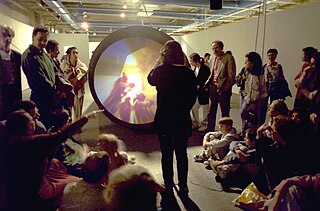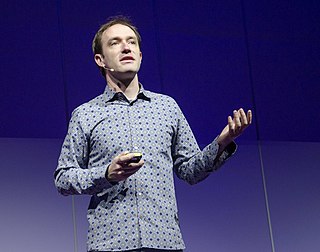Related Research Articles

The Atanasoff–Berry computer (ABC) was the first automatic electronic digital computer. Limited by the technology of the day, and execution, the device has remained somewhat obscure. The ABC's priority is debated among historians of computer technology, because it was neither programmable, nor Turing-complete. Conventionally, the ABC would be considered the first electronic ALU – which is integrated into every modern processor's design.
Ubiquitous computing is a concept in software engineering, hardware engineering and computer science where computing is made to appear anytime and everywhere. In contrast to desktop computing, ubiquitous computing can occur using any device, in any location, and in any format. A user interacts with the computer, which can exist in many different forms, including laptop computers, tablets, smart phones and terminals in everyday objects such as a refrigerator or a pair of glasses. The underlying technologies to support ubiquitous computing include Internet, advanced middleware, operating system, mobile code, sensors, microprocessors, new I/O and user interfaces, computer networks, mobile protocols, location and positioning, and new materials.

Ivan Edward Sutherland is an American computer scientist and Internet pioneer, widely regarded as a pioneer of computer graphics. His early work in computer graphics as well as his teaching with David C. Evans in that subject at the University of Utah in the 1970s was pioneering in the field. Sutherland, Evans, and their students from that era developed several foundations of modern computer graphics. He received the Turing Award from the Association for Computing Machinery in 1988 for the invention of the Sketchpad, an early predecessor to the sort of graphical user interface that has become ubiquitous in personal computers. He is a member of the National Academy of Engineering, as well as the National Academy of Sciences among many other major awards. In 2012, he was awarded the Kyoto Prize in Advanced Technology for "pioneering achievements in the development of computer graphics and interactive interfaces".

Interactive art is a form of art that involves the spectator in a way that allows the art to achieve its purpose. Some interactive art installations achieve this by letting the observer walk through, over or around them; others ask the artist or the spectators to become part of the artwork in some way.

Lotfi Aliasker Zadeh was a mathematician, computer scientist, electrical engineer, artificial intelligence researcher, and professor of computer science at the University of California, Berkeley. Zadeh is best known for proposing fuzzy mathematics, consisting of several fuzzy-related concepts: fuzzy sets, fuzzy logic, fuzzy algorithms, fuzzy semantics, fuzzy languages, fuzzy control, fuzzy systems, fuzzy probabilities, fuzzy events, and fuzzy information. Zadeh was a founding member of the Eurasian Academy.

William Daniel "Danny" Hillis is an American inventor, entrepreneur, and computer scientist, who pioneered parallel computers and their use in artificial intelligence. He founded Thinking Machines Corporation, a parallel supercomputer manufacturer, and subsequently was Vice President of Research and Disney Fellow at Walt Disney Imagineering.
The expression computational intelligence (CI) usually refers to the ability of a computer to learn a specific task from data or experimental observation. Even though it is commonly considered a synonym of soft computing, there is still no commonly accepted definition of computational intelligence.

A tangible user interface (TUI) is a user interface in which a person interacts with digital information through the physical environment. The initial name was Graspable User Interface, which is no longer used. The purpose of TUI development is to empower collaboration, learning, and design by giving physical forms to digital information, thus taking advantage of the human ability to grasp and manipulate physical objects and materials.
Joanna Berzowska is an Associate Professor of Design and Computation Arts at Concordia University in Montreal. Her work and research deal primarily with "soft computation": electronic textiles, responsive clothing as wearable technology, reactive materials and squishy interfaces.

Rosalind Wright Picard is an American scholar and inventor who is Professor of Media Arts and Sciences at MIT, founder and director of the Affective Computing Research Group at the MIT Media Lab, and co-founder of the startups Affectiva and Empatica.
Simon Graeme Penny is an Australian artist, theorist, curator and teacher in the fields of digital cultural practices, embodied interaction and interactive art.

Electronic textiles or e-textiles are fabrics that enable electronic components such as batteries, lights, sensors, and microcontrollers to be embedded in them. They are not to be confused with smart textiles, which are fabrics that have been developed with new technologies that provide added value. Many smart clothing, wearable technology, and wearable computing projects involve the use of e-textiles.
Benjamin Fry is an American designer who has expertise in data visualization.
Lateral computing is a lateral thinking approach to solving computing problems. Lateral thinking has been made popular by Edward de Bono. This thinking technique is applied to generate creative ideas and solve problems. Similarly, by applying lateral-computing techniques to a problem, it can become much easier to arrive at a computationally inexpensive, easy to implement, efficient, innovative or unconventional solution.

Constantinos Daskalakis is a Greek theoretical computer scientist. He is a professor at MIT's Electrical Engineering and Computer Science department and a member of the MIT Computer Science and Artificial Intelligence Laboratory. He was awarded the Rolf Nevanlinna Prize and the Grace Murray Hopper Award in 2018.

Danny Cohen was an Israeli American computer scientist specializing in computer networking. He was involved in the ARPAnet project and helped develop various fundamental applications for the Internet. He was one of the key figures behind the separation of TCP and IP ; this allowed the later creation of UDP.

Sergey Victorovich Ulyanov was born on 5 December 1946 in Engels, Saratov region, USSR.
Patrick Denis Lincoln is an American computer scientist leading the Computer Science Laboratory (CSL) at SRI International. Educated at MIT and then Stanford, he joined SRI in 1989 and became director of the CSL around 1998. He previously held positions with ETA Systems, Los Alamos National Laboratory, and MCC.
Janice Richmond "Jan" Lourie is an American computer scientist and graphic artist. In the late 1960s she was a pioneer in CAD/CAM for the textile industry. She is best known for inventing a set of software tools that facilitate the textile production stream from artist to manufacturer. For the Graphical Design Of Textiles process she was granted IBM's first software patent. Other projects, in differing disciplines, share the focus on graphic representation. She returns throughout an ongoing career to the stacked two-dimensional tabular arrays of textiles and computer graphics, and the topological structures of interrelated data.

James Patten is an American interaction designer, inventor, and visual artist. Patten is a TED fellow and speaker whose studio-initiated research has led to the creation of new technology platforms, like Thumbles, tiny-computer controlled robots; interactive, kinetic lighting features; and immersive environments that engage the body.
References
- ↑ Sculpted computational objects with smart and active computing materials (MIT PhD thesis) (Thesis). Massachusetts Institute of Technology. 2001. hdl:1721.1/8674.
- ↑ Post, R., Orth, M., Russo, P., and Gershenfeld, N. E-broidery: design and fabrication of textile-based computing. IBM Systems Journal 39, 3-4 (2000), 840–860.
- ↑ US 6210771 "Electrically active textiles and articles made therefrom."
- ↑ "Faculty, alumna win United States Artists grants (MIT News Office)".
- ↑ "USA Fellows, Maggie Orth".
- ↑ "Mineta San Jose International Airport Public Art Program Audio Tour".
- ↑ "Fuzzy Apparatus, in Patent Pending Show".